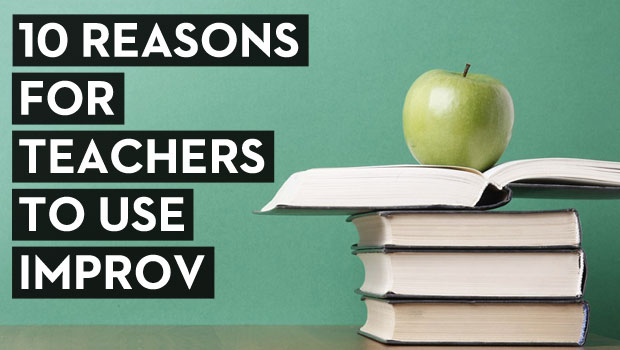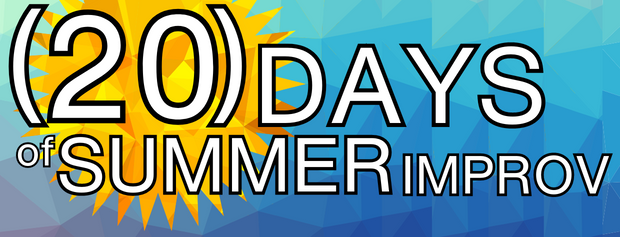Improv and theater games are fun for kids from kindergarten through high school. It gets a class full of students moving, playing and laughing. However, having a good time isn’t always the same thing as good pedagogy. Beyond simply engaging and entertaining students, there are many reasons for teachers to use improv in the classroom. Here are 10 of them.
10. Change the Vocabulary, Change the Behavior
“Yes, and...” is the mantra of improvisation. In improv, we agree and add. Many classrooms, particularly when it comes to managing behavior, are run by a system of “no.” By making improvisation an important piece of the classroom culture, the vocabulary of behavioral expectations change.
If someone is talking out of turn in class, they have “taken focus,” which they should give back to the student who has the floor. Our classroom is an “ensemble,” which we must always work to keep on the same page. Change the vocabulary-- and change the behavior.
9. Free the Mind Now; Judge Later
Students don’t just get stuck saying “no” to their teacher, they get stuck saying “no” to themselves, as well.
As teachers, we encourage them to say “no” to themselves. It’s necessary. Saying no is a part of the discriminating processes of editing, self-correcting and coming up with the best answer. The problem is, creativity requires a complete state of “yes, and.” Following ideas without judging them can be a difficult skill, and improv is the best tool to teach it. Many improv games such as the “ad game” isolate this skill.
8. Build Public Speaking Skills
For students who are nervous about getting up in front of the class to present, playing improv games and following directions with their friends can be a great way to prepare. They have the safety of the group and can join in the fun as they feel comfortable. This can make the front of the class seem like a less scary place.
For those students who already have confidence presenting-- but need to work on volume and clarity-- improv provides an opportunity both for them to practice and you to coach them.
7. Foster Collaboration in Groups
There is a place for assigning roles among group members, but sometimes what you want is a true collaboration where everyone pitches in as an ensemble.
Improv teaches participants to step up when another idea is needed (taking the focus) and to cede the floor when another student wants to share (giving the focus). It teaches to honor the ensemble and what is being created over what any individual wants to say. An improvisational component can help with almost any group assignment.
6. Create Something That’s Truly Shared
Creating is a high-level critical thinking skill, and when you have created something as a class or group for which no individual can take credit, you have created something very special, indeed.
Perhaps it’s a story your students wrote the beginning of one word at a time. Or a new invention that can be examined later individually or in small groups. Or if you are teaching an important new science concept, your class can develop a theory about it together at the beginning of the unit, which can be refined and changed as the unit progresses.
5. Use Multiple Intelligences
Administrators don’t talk much about Howard Gardner’s multiple intelligence theory right now, but that doesn’t mean it’s not still a part of good teaching. Improv physicalizes learning, meaning that spatial learners, kinesthetic learners and interpersonal learners benefit when it is used.
Physicalizing learning through improv improves student success with material. Depending on your particular students, this can also be an effective way to differentiate for special education students.
4. Teach the Nitty-Gritty
There are particular improv games that build physical, ensemble-based expressions of concepts we teach. Any thing that has components (like a motor), is a process (like photosynthesis), or has a sequence (like a story from fiction or history) can be taught through games such as “parts of a whole,” “build a machine,” “string of pearls,” “conducted story,” and “tableau.”
3. Present Multiple Points of View
Nothing is better than improv for seeing things from a different point of view. Through assuming the worldview of a character, students can change their perspective. This helps students to understand the motives of characters both real and fictional. As Eleanor Roosevelt, a student can improvise an answer to what she thinks of Herbert Hoover, what she would think of Michelle Obama, what she wants on her pizza.
2. Discover New Stars
You will find there is a group of students who excel at this kind of work and receive positive feedback from you and their peers. For many of these students, being a star in an academic setting will be a new feeling. That’s a one of a kind motivator and can make a big difference in a child’s life.
1. Practice What You Preach
Improv will make you a more positive, creative teacher. “Yes, and…” is a refreshing answer for students to hear from you, too. Improv will make you a better listener in the classroom, and more open to new directions your class might take.
Want to learn more about using improv fundamentals in your classroom? We offer Special Workshops for educators and fun opportunities for class groups either on location or here at The Second City.
Jeff Sevener is an improv instructor in the Second City Training Center’s Kids & Teen Program, a Music and History teacher at Chicago’s Austin Polytechnical Academy and a graduate of the Second City Conservatory.

 Shows & Tickets
Shows & Tickets  Chicago Venue Info
Chicago Venue Info  Classes & Education
Classes & Education  Second City Works
Second City Works  Second City Network
Second City Network  Our Legacy
Our Legacy 












